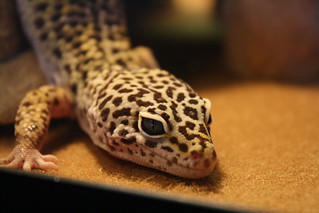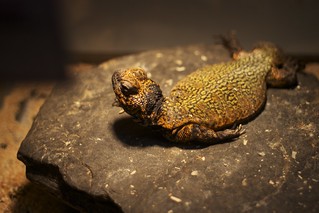 |
| Leopard gecko example (Photo credit: Wikipedia) |
Leopard Geckos are nocturnal, ground-dwelling reptiles that were originally found in the deserts of Pakistan, India, Afghanistan, and Iran (although they live in the desert, their natural substrate is not sand, as I will discuss later under substrate). The scientific name is Eublepharis macularius (which means "true" "eyelid" "spot"). They are one of the few geckos that actually have eyelids, and they naturally have spots. There are many different morphs of Leopard Geckos that I will go into in more detail later. Many people now breed Leopard Geckos, and you can purchase them at a local pet store (or through breeders). They may live up to 20 years if properly cared for, and reach an average size of 8-10 inches when they reach adulthood (approximately 1-2 years into the gecko's life).
2.1 - Housing
First things first, you should never house multiple male Leopard Geckos together. They are territorial and may fight each other. You shouldn't house a female and a male together either unless you want babies. However, you can house multiple females together, but you must watch them carefully because there can be situations where one may be a leader. Some signs of "bullying" would be marks on one of the geckos, one getting more food than the other, or one of the geckos getting a good bit larger than the other.
Next question one might have is, "How big should my tank be?" Well, this depends on how many geckos you plan to house in the tank. A 10-gallon tank would be on the small side for one gecko, but it works. My opinion is that a 20-gallon tank works best for 2, maybe 3 geckos and a 30-gallon tank can fit up to 4 or 5 (this area is debated, so the fewer geckos, the safer). I do not suggest you ever house more than 5 geckos in one tank. Another thing to consider when purchasing a tank is that Leopard Geckos don't climb as much as other geckos, so it is better to buy a tank with more surface area. For example: A 20 gallon tank (24" x 12" x 16") meaning 24" by 12" surface area, compared to a 20 gallon long (30" x 12" x 12") which has 30" by 12" surface area. You could get those two tanks for the same price, but the 20 gallons long would be a better choice.
3.1 - Feeding
When it comes to feeding, babies/juveniles eat more often than adults because it is important for them to grow a big healthy tail. A good rule of thumb to go by is once a day for any gecko 1 1/2 years and every other day for older geckos. You should let your gecko eat as much as he or she can in 15 minutes. They have good judgment and will not eat more than they can. When they are younger, they may eat too much and regurgitate food. This is just a learning process and doesn't hurt your baby, it should teach them not to eat that much. When your gecko grows older you should keep feeding it as much as he/she can eat in 15 minutes, but only feed it every other day. A good rule of thumb to use is don't feed anything longer than the width between your gecko's eyes (or 3/4 of their head). This will keep your gecko from swallowing something too big and choking, although they usually regurgitate. To learn more about what to feed your geckos, continue reading through the next couple of sections.
4.1 - Health
Health is an important part of your gecko's life, of course. Some positive signs of a healthy gecko are:
- Feeding well.
- Growing (if a baby).
- Is active at night.
- Has a fat tail (it is OK if younger geckos don't have fat tails, as they are still growing).
- And is acting normal
You should always check for signs of unhealthiness. Also, if you get a new gecko (or geckos) and you are planning to house them with another gecko that you already had or you just bought, you should "quarantine the new gecko(s). This is a process where you take the new gecko and put him in a tank by himself for about 3 months. If you don't do this, and your gecko came with a disease, the disease would spread to the other gecko and both of them would have died. After the 3 months, you can safely house that gecko with another one. This is just a safe way to determine if a Leopard Gecko is "disease-free".
|






